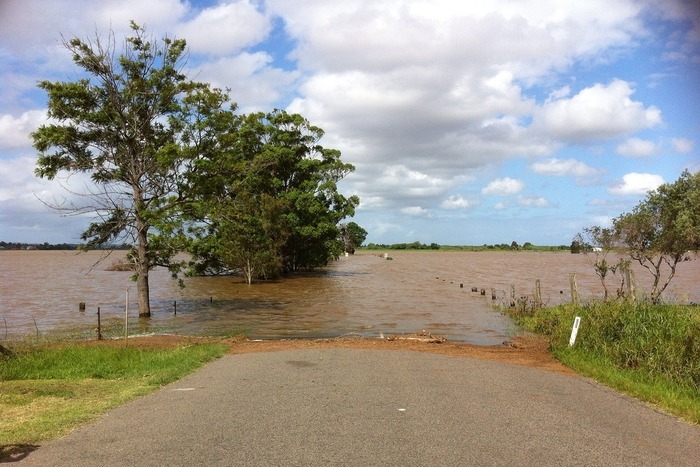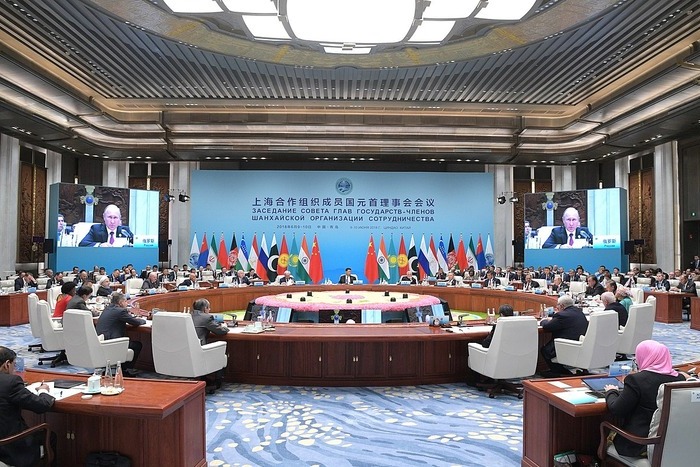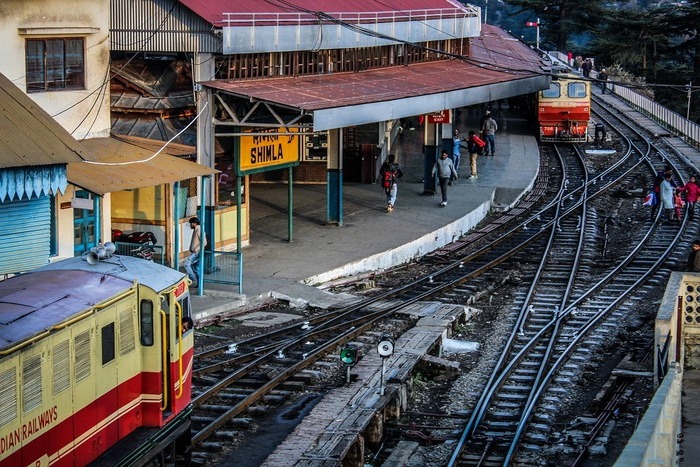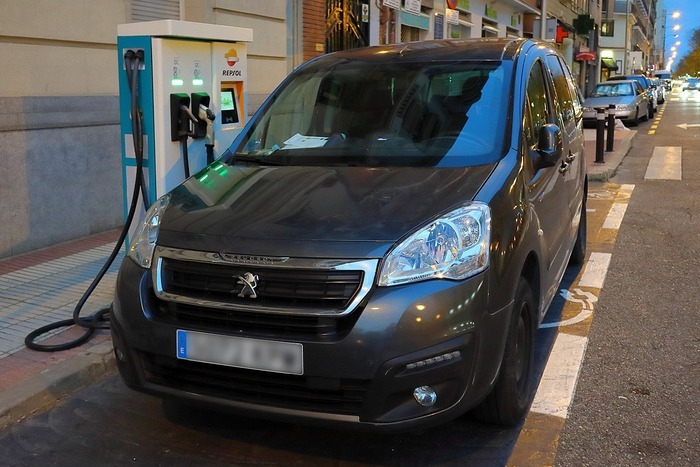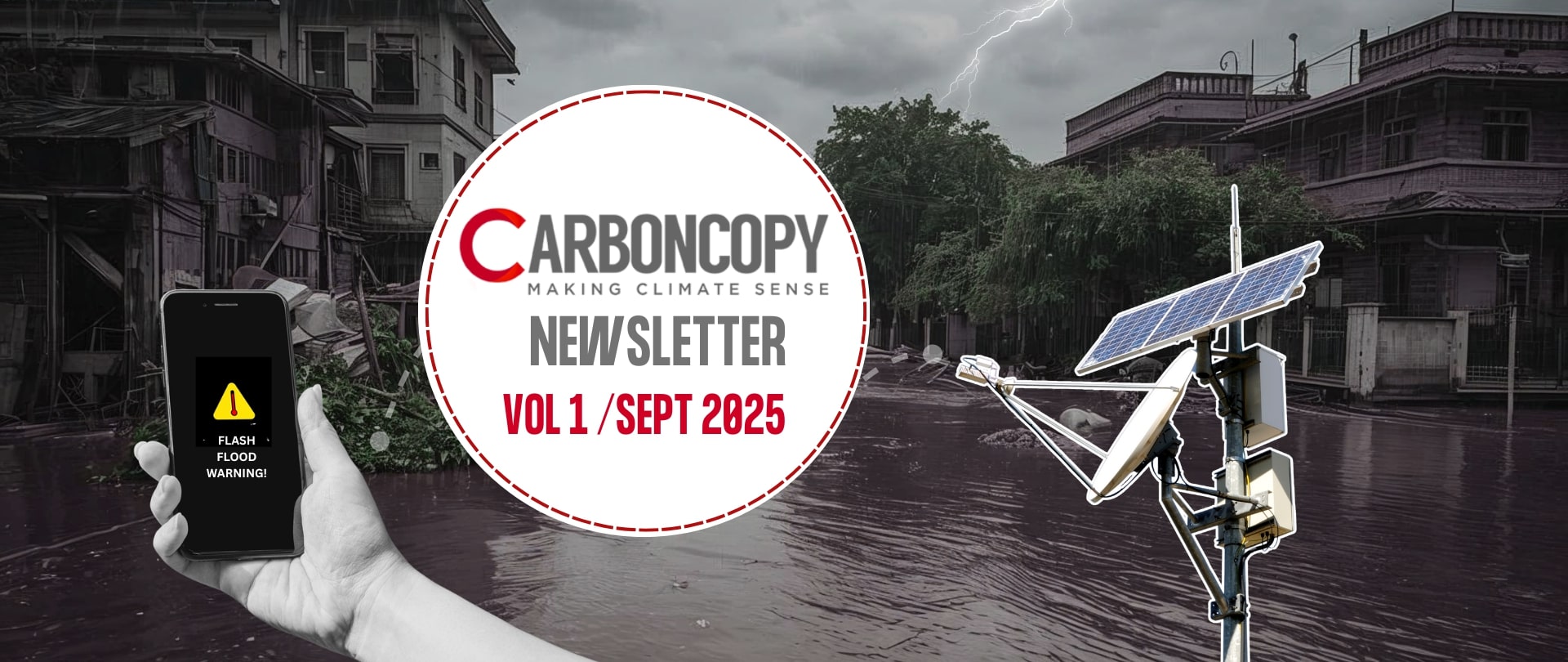
As IMD celebrates its 150 years of existence, it has also faced criticism for failing to forecast the intensity and timing of rainfall. Photo: Riddhi Tandon
Inside India’s Struggle to Build a Reliable Early Warning System
Part one of CarbonCopy’s two-part series on India’s forecasting challenge explores how the IMD is grappling with climate-fueled extremes, the gaps in early warnings, and what it will take to strengthen the country’s defense against intensifying disasters
In the mist-clad valleys of the Himalayas, where villages cling to fragile slopes and rivers roar with monsoon fury, the India Meteorological Department (IMD) is grappling with one of its greatest challenges: predicting the unpredictable. Each year between June and September, unusual bursts of rainfall sweep across the Himalayan states and beyond, bringing flash floods, landslides, and devastation in their wake. While the IMD—an institution that recently marked 150 years of its existence—has been the nation’s frontline weather sentinel, it has also faced repeated criticism for failing to anticipate the intensity and timing of rainfall in these vulnerable regions.
Climate change has only made the job harder. Altered rainfall cycles, warmer air currents, and shifting monsoon patterns are making traditional forecasting models increasingly unreliable. The IMD’s current radar systems and observation networks, although expansive, struggle to capture the volatile microclimates of the mountains where a single cloudburst can unleash disaster. Experts argue that the department urgently needs to upgrade its forecasting arsenal, blending advanced satellite monitoring with high-resolution models designed for extreme terrain.
In this battle against uncertainty, technology could become IMD’s most powerful ally. Artificial intelligence and machine learning promise sharper predictions, better risk mapping, and quicker warnings—tools that may help save lives as climate extremes intensify. The question is whether the IMD can reinvent itself fast enough to meet the storms of tomorrow.
“India’s Wettest August in Decades: A Monsoon on Overdrive”
Northwest India has endured an unusually wet core-monsoon (June–August) this year, capped by a record-soaked August. The India Meteorological Department (IMD) reports that northwest India logged 265 mm in August alone—the region’s wettest August since 2001— driving June–August rainfall to 614.2 mm, about 27% above the long-period average (LPA) of 484.9 mm. Nationally, June–August rainfall reached 743.1 mm, roughly 6% above the LPA and there are warnings for September as well.
Himachal Pradesh is emblematic of the severity. The state recorded 431.3 mm in August, 68% above its normal 256.8 mm—its wettest August in 76 years (since 1949). Consecutive days of heavy rain have triggered widespread landslides, blocked more than a thousand roads and raised the season’s death toll, underscoring how saturated slopes convert intense bursts into disasters.
Uttarakhand has swung wetter than average this season. By mid-August, the state had received ~947.9 mm, about 14% above its LPA of 830.1 mm, with subsequent red alerts as moisture from the Bay of Bengal met an active western disturbance. Cloudburst-type events and debris flows have punctuated the season, even in districts showing “normal” cumulative totals—highlighting how short, intense cells can overwhelm steep catchments.
Punjab saw its wettest August in 25 years with 253.7 mm rainfall, 74% above normal, flooding rivers Sutlej, Beas and Ravi. In Jammu & Kashmir, seasonal rainfall was near normal until August 17, before a late-August deluge brought 612 mm, 726% above normal, the highest since 1950.
Farther south, Maharashtra’s August was emphatically active. Statewide rainfall reached about 331.8 mm, 18% above the normal 280.2 mm. Mumbai alone clocked roughly 891 mm in August—well above its long-term average near 561 mm—and pushed its season total past 2,193 mm, exceeding the city’s seasonal norm of about 2,102 mm. The Konkan–Ghats corridor saw repeated very heavy to extremely heavy spells linked to Bay-of-Bengal lows propagating west.
The through-line is clear. More moisture in a warming atmosphere, funneled by the monsoon and pinned by orography, is amplifying both the frequency and intensity of heavy-rain days in hill states and adjoining plains. August’s 265 mm over northwest India (highest since 2001) is the statistical signal; the landslides in Himachal, the river floods across Punjab, the late-season surge in Jammu, and the urban flood stress in Mumbai are the lived realities. With IMD flagging an above-normal September and a likely delayed withdrawal, the hydrological load on already saturated basins will persist into early autumn, testing embankments, hill roads and emergency responses across the region.
Beyond Cloudbursts: Slow Rainfall Weakens Himalayas
Disasters in the Himalayas are often hastily described as “cloudbursts.” While that explains some events, experts caution that not all devastation stems from sudden torrents. Increasingly, prolonged moderate rainfall at higher elevations is being observed, as clouds condense in zones that historically remained drier. Experts and meteorologists link this shift to rising temperatures in the upper Himalayas, a clear imprint of climate change.
Madhavan Rajeevan, former secretary of the Ministry of Earth Sciences, who recently co-authored the report South Asian Summer Monsoon: Processes, Prediction, and Societal Impacts with climate scientists Parthsarathy Mukhopadhyaya and Arindam Chakraborty, stresses that global warming is already reshaping rainfall. Longer dry spells are now interspersed with short, intense bursts of precipitation.
“With global warming, rising humidity is loading the atmosphere with excess moisture. But this warming also stretches dry spells, holding back rain until the skies release it in sudden, violent bursts,” Rajeevan told CarbonCopy. “The result is a dangerous pattern—long lulls broken by cloudbursts and flash floods—that is now playing out across India’s mountains and plains.”
Adding to this, Mrutyunjay Mohapatra, Director General of the India Meteorological Department (IMD), explains how rising temperatures intensify rainfall. Warmer air can hold more moisture, and with every 1°C increase, its relative humidity rises by about 7%.
“This creates favourable conditions for convective and deep thunderstorm activity. So due to climate change, especially in the tropics, the frequency and intensity of heavy rainfall is increasing. Of course, there are variations from place to place, but the overall trend is clear,” he says.
Rajeevan adds that the data backs the trend. “If you really take the past hundred years of data and analyse extreme precipitation or heavy rainfall events, we get a systematic trend that the frequency of extreme rainfall is increasing. And that is not everywhere. Especially over central plains, the west coast, and the foothills of the Himalayas, the frequency of such events is increasing. That is mainly attributed to global warming.”
In the higher Himalaya, the risk is amplified by topography. Valleys are sharply vertical and slopes rest on fragile glacial moraines. Even prolonged moderate rainfall can oversaturate this loose material, unleashing landslides and floods as destructive as any cloudburst.
Geologist Navin Juyal says, “For years, I thought the Himalaya was still some distance from climate change impacts. But recent large-scale events across the region show temperature rise is now knocking at the Himalaya’s door. With July 2023 recorded as the hottest month in 120,000 years, I fear we are moving dangerously close to the 1.5°C tipping point. Once crossed, the changes will be irreversible, and the fragile Himalayan cryosphere could face massive devastation.”
This is part of a larger phenomenon called elevation-dependent warming (EDW), where mountain regions heat faster than the lowlands. EDW accelerates glacier retreat, exposes darker rock that absorbs more heat, and loads the atmosphere with additional moisture. Together, these changes are amplifying extreme rainfall and destabilizing the Himalayan cryosphere.
In an interview to Carboncopy, Mohapatra, repeatedly underlined how fragile the Himalayan ecosystem is—pointing out that even 50 mm of rain can destabilise slopes and trigger landslides. He notes that in July, when glacier melt peaks, elevation-dependent warming amplifies the risks dramatically. Against this backdrop, the need for a robust forecasting and early warning system is no longer optional but essential—not just for the Himalayas but for safeguarding lives and economies across the entire tropical region.
Can India’s Forecasting Agencies Keep Up With Extreme Rain?
India’s ability to cope with intensifying rainfall and floods hinges on the performance of two agencies: the IMD and the Central Water Commission (CWC). Both sit at the centre of the country’s early warning and flood-management architecture. Both have made advances. And both face serious credibility gaps.
In recent years, the IMD has significantly strengthened its forecasting and early warning capacity. Once criticised for broad, often vague predictions, the agency now issues more precise, region-specific alerts that reach millions through mobile apps, WhatsApp, X, and Common Alert Protocols.
Its biggest advances have come from technology: high-resolution numerical models under the Bharat Forecast System, supported by supercomputers such as Mihir, Pratyush, and Arka, enable faster and finer simulations of monsoon dynamics. At the same time, IMD has expanded its Doppler weather radar network, improving real-time monitoring of thunderstorms and cyclones. Satellite platforms like INSAT-3D and 3DR have enhanced cloud and rainfall assessments. On the ground, a wider network of automatic weather stations and rain gauges is filling critical observational gaps, from cities to remote regions.
Mohapatra explains that India is doubling down on radar capacity to sharpen extreme weather forecasting — especially crucial in the tropics, where storms form swiftly and unpredictably.
He says: “With radar coverage expanding from 37 to 73 sites by 2025-26—and aiming for 126 by 2026—IMD is boosting its ability to detect severe weather well before it unfolds. These upgrades, paired with improved modelling and faster data feeds, will bring critical lead time to forecasters and communities alike.”
Yet capacity does not always translate into accuracy. IMD bulletins often remain broad and unspecific, flagging “heavy rain in northwest India” rather than pinpointing which districts or river catchments will be hit. This gap is critical. Local administrations cannot pre-position relief or evacuate communities if the warning map covers entire states.
Further, many expanding urban and hill regions still lack dense observation stations, leaving large blind spots. The agency has acknowledged the need to shift from rainfall totals to impact-based forecasts, but operationalising this remains a work in progress.
IMD has faced sharp criticism after repeated forecast misses—whether it was predicting a “pleasant” May in Delhi this year or underestimating Mumbai’s July rains by 42% last year. Such lapses often spark comparisons with European or US agencies, where forecasts are considered more reliable.
But scientists caution that this is not a level playing field. Mid-latitude weather systems in Europe are better organised and easier to track, while India’s tropical setting—complicated further by the Himalayas’ rugged terrain—makes accurate prediction far more complex.
As Dr. Raghavan Krishnan, former director of the Indian Institute of Tropical Meteorology (IITM), says, “We must remember that mid-latitude weather, like in Europe, is easier to predict than tropical weather. India has made major advances in cyclone forecasting, but Himalayan extremes are far more complex because of the terrain and tropical influences. Climate change is also preconditioning the region for more such events. The challenge is greater here, but the way forward lies in combining technology, research, and preparedness.”
CWC: The Rule Curve Question
If IMD’s weakness is precision, CWC’s is dam management transparency. The commission monitors river flows and oversees reservoir operations, but has been repeatedly accused of allowing uncoordinated, large-volume dam releases that amplify floods downstream.
The heart of the issue lies in rule curves—the seasonal operating guidelines that define how much water a dam should store or release. In practice, these curves are either outdated, poorly enforced, or simply withheld from the public. Punjab’s 2025 floods reignited the debate, with experts pointing to near-simultaneous releases from Bhakra, Pong, and Ranjit Sagar dams that worsened inundation across districts. Similar questions were raised after the Kerala floods of 2018, when sudden releases coincided with peak rainfall. Without strict adherence to rule curves and real-time disclosure of reservoir levels, CWC risks being seen not as a flood manager but a flood multiplier.
Despite criticism over flood severity, the Central Water Commission and dam authorities have consistently denied any mismanagement. For instance, BBMB Chairman Manoj Tripathi emphasized that the Bhakra and Pong reservoirs played a protective role, arguing that “had it not been for the dams, Punjab would have faced floods as early as June” under the extraordinary water inflows this season. Similarly, following Kerala’s 2018 deluge, the then Water Resources Minister Mathew Thomas had cited CWC findings that extreme rainfall—not dam mismanagement—was to blame, as the rainfall far exceeded any dam’s capacity to mitigate
Better coordination between the IMD and the CWC could sharply reduce losses from floods and droughts. If IMD’s rainfall forecasts are harnessed effectively, and CWC incorporates them into updated and well-enforced rule curves, both floods and water scarcity can be mitigated, say experts.
Dr. Madhavan Rajeevan, former Secretary of the Ministry of Earth Sciences (under which IMD functions), says, “The CWC is responsible for flood warnings in this country, while IMD provides the rainfall forecasts needed for such alerts. CWC then estimates how much water will flow into rivers and how levels will rise. But in my understanding, they still rely on outdated empirical methods, even though much better forecasting techniques are now available. I am not blaming CWC, but both their systems and IMD’s own methods have clear scope for improvement.”
AI Joins India’s Weather Playbook
IMD still banks on physics-based Numerical Weather Prediction (NWP) systems powered by supercomputers and dense observation networks for its forecasts. But the department has also begun deploying Artificial Intelligence and Machine Learning, from AI-driven cyclone tracking and intensity estimation to local-scale nowcasting tools — marking a shift from purely physical models to hybrid, data-powered forecasting.
Rajeevan welcomed the use of AI for faster and more wide-ranging weather forecasts. Citing examples such as Google’s GraphCast model, he argued that advanced technology can significantly enhance accuracy.
“The GraphCast can run even on a small computer,” Rajeevan said. “It doesn’t need the massive machines that IMD relies on today. That makes it useful, because AI models can complement and strengthen our physical models.”
IMD Director General Mrutyunjay Mohapatra underscored that the department’s vast archive of weather records could become a game-changer in building powerful AI systems. Like other countries, he said, India too is moving to harness the technology.
“IMD is a 150-year-old institution with an enormous digital database,” Mohapatra said. “We have weather records going back to 1901, all digitised. AI is essentially data-driven—so why shouldn’t we use this treasure of information and scientific knowledge? IMD can be a great laboratory for such work, and we are partnering with IITs, IIITs and other universities to develop AI models.”
Clearly, India’s deepening rainfall crisis is as much about governance as it is about science. A warming climate is amplifying extremes, but better forecasts, smarter dam management, and stronger coordination can turn risk into resilience. With AI tools, expanded radar networks, and a century of weather data at hand, the question now is whether India can act fast enough to translate warnings into saved lives and safer futures.
In the next report:
CarbonCopy turns the spotlight on the private sector’s role in weather forecasting—examining how private players can collaborate with IMD and what that means for the market and end users.
Over 100 people have been killed in Pakistan and at least 55 in India, in Punjab floods. Photo: Pixabay
Extremely heavy rain flood Punjab, over hundred killed, 2.5 million forced to flee
Over 100 people have been killed in Pakistan and at least 55 in India, in Punjab floods.
Punjab Revenue Minister Hardeep Singh Mundian said 2,303 villages required urgent relief and resettlement, PTI reported
The Hindu reported people were anxious after suffering massive loss of farm produce and jobs.
Around 2.5 million people have been forced to flee in Pakistan’s Punjab province, reported TOI and the Dawn. The newspapers reported that the whole province is on the move. The Provincial Disaster Management Authority (PDMA) has deployed “1,500 boats …to rescue stranded families living along the Chenab, Ravi and Sutlej rivers,” the report said.
Down to Earth analysed data for 33 days (August 1 to September 3) and found that rescue and relief started only after huge losses occurred and pressure increased on officials. In India, farmers will get compensation of Rs 20,000 per acre, exemption on loans for 6 months and they can sell soil and silt deposited in their fields, the state government said.
Punjab, Himachal, Uttrakhand: Extreme weather batter north India this monsoon, data from states reveal
Punjab has averaged 400% more rainfall in the last fortnight of August than its normal, reported Down to Earth.
The outlet said “Himachal Pradesh broke all records as heavy and extremely heavy rain lashed” the Himalayan state for over 90% of the days in the past three months.
“Himachal Pradesh, which is upstream of Punjab, has experienced incessant rains and between August 28 and September 3, the state saw over 300% more rainfall than the weekly average…wiping out livelihoods, property and years of developmental investments,” the report said.
This monsoon season, “the western disturbances seem to have developed a fever. Instead of the occasional one or two which would come during the southwest monsoon, there have been 19 till the first week of September this year. These winds are literally colliding with the winds of monsoon,” wrote Sunita Narain of DTE.
Cloudbursts are being made “scapegoats” for India’s floods
Heavy rains that triggered flash floods and landslides in the Himalayan states were wrongly identified as cloudbursts in the media, the phenomenon has been made a scapegoat to mask systemic failures ignoring the role of “fragile slopes, deforestation, road-cutting and unregulated construction,” reported Dialogue Earth.
The outlet explained: “Unplanned and rampant infrastructure development in the region plays a significant role in these disasters…When rains flow down from the hills, they bring with them mud and stones, mixed in with construction waste from road-building projects. Such waste is often dumped in rivers and along slopes in the Himalayas. This combination can cause devastating flash floods in areas surrounding the rivers.” Simplifying the cause of these disasters as cloudbursts or landslides isn’t good enough, “every heavy rain of less than 100 mm in one hour occurring in 2-3 hours can cause these flash floods, this is especially true with rain in the mountains.” The report said quoting scientist.
Mohd Farooq Azam, scientist at the International Centre for Integrated Mountain Development (ICIMOD) Disasters in the region points out:
In recent years, the South Lhonak glacial lake outburst flood in 2023 and the Til village flash flood in May 2025 were primarily caused by permafrost-linked landslides. The Chamoli disaster (2021) in Uttarakhand was variously called a cloudburst and a glacial lake outburst flood. But the real trigger had been a massive rock-ice avalanche, starting at 5,500 metres and cascading into two rivers, ICIMOD explained.
The 2013 Kedarnath flooding, one of India’s worst disasters, with over 6,000 deaths, was initially labelled a cloudburst, a descriptor denied by the IMD days later. Subsequent studies found the event to be a combination of extreme, sustained rainfall linked to snowmelt and overflow from an upstream lake. The lack of automatic rain gauge or hourly measurements meant the occurrence of cloudburst could not be determined. The flood’s impact was exacerbated by debris from landslides and collapsed riverbanks rushing
Apples rot in hundreds of trucks as landslides and heavy rain block key Kashmir highway
Excessive rainfall and landslides triggered by rain in Kashmir blocked major highways unleashing huge losses on Kashmir’s apple industry. Hundreds of apple trucks were stranded after the closure of Srinagar-Jammu National Highway at Qazigund. 1,500 apple laden trucks, right from Anantnag outskirts up to Qazigund tunnel are lined up waiting for a green signal, HT reported. There is no railway cargo service for Kashmir fruit produce.
The newspaper said the growers have already suffered losses worth ₹500 to 700 crore because of blocked roads. Usually in September and October around 2,000 to 2,500 apple trucks are dispatched across the country. The highway condition has forced farmers to delay harvest and close wholesale markets in Kashmir.
J&K Chief Minister Omar Abdullah assured a delegation of fruit dealers that the introduction of Railway Cargo Service for fruit produce of Kashmir has already been raised with the Union Railway Ministry.
‘Landmark’ report’s grim warning: Rising sea levels will threaten 1.5 million Australians by 2050
A “horrifying” climate report warned that “one and a half million Australians living in coastal areas are at risk from rising sea levels by 2050”, reported The Sydney Morning Herald. BBC said: “Australia’s first National Climate Risk Assessment predicted more frequent and severe climate hazards like floods, cyclones, heatwaves, droughts and bushfires. The study looked at three global warming scenarios – above 1.5°C, above 2°C and above 3°C. The 72-page report – released days before the government announces its emissions reduction targets for 2035 – found that no Australian community will be immune from climate risks that will be ‘cascading, compounding and concurrent’.” The country’s climate change minister Chris Bowen used the report to call for a “strong 2035 emissions reduction target, The Guardian reported. News.com.au also carried the news, warning that “property values could dive by up to A$500bn by 2050 as homes become uninsurable and floods, cyclones and bushfires lay siege to Australia, according to a grim new climate risk assessment.”
Protect Arctic from ‘dangerous’ climate engineering, scientists warn
Attempts to tackle climate change by “manipulating the Arctic and Antarctic environment are dangerous, unlikely to work and could distract from the need to ditch fossil fuels”, BBC News reported. The report is based on findings of a group of “more than 40 researchers”. The report noted that polar “geoengineering” techniques designed to cool the planet through artificially thickening sea-ice or releasing reflective particles into the atmosphere have “gained attention”.
The Guardian also covered the research and said polar geoengineering schemes are “so flawed that no amount of research could resolve them and that they treat only the symptoms and not the causes of the climate emergency”. The Times report on the study said the UK government is spending £10m to see if Arctic ice could be thickened by pumping seawater onto the surface over winter months.
China announced it will invest in building 10 gigawatts (GW) of solar and 10 GW of wind power across SCO member countries over the next five years. Photo: Wikimedia Commons
SCO summit concludes: ‘Energy diplomacy’ of China, Russia, India
The Shanghai Cooperation Organisation (SCO) summit concluded in Tianjin. China announced it will invest in building 10 gigawatts (GW) of solar and 10 GW of wind power across SCO member countries over the next five years, a large increase on the 1 GW of solar and 0.3 GW of wind China invested in SCO states since 2019. The Power of Siberia-2 gas pipeline was also mentioned which if built could push the Russian share of China’s gas imports up to a third by the 2030s, reported Dialogue Earth adding that: “India, too, continues buying discounted Russian crude despite new US tariffs…The message is that China is not isolated. Others in Asia are also resisting US pressure.”
The outlet explained that: “For New Delhi, this engagement could indeed help streamline trade and knowledge sharing on green technologies. But it will remain cautious in order to protect its domestic supply-chain reforms. It will continue pursuing diversification to prevent falling into new dependencies.”
The Wire noted that “headwinds” of “opposing interests” of a “vast tent” of Belarus, Vietnam, India, Pakistan, Armenia, Azerbaijan, Turkey and Iran (aside from Russian and China).
The outlet explained that all the SCO members and partner countries together constitute just about a 10% share of its overall merchandise exports market. “Therefore, promoting markets for Indian goods in Russia and China, the two other giants of the SCO, as well as to the other countries, must be of primary importance.”
For Pakistan, Dialogue Earth noted, the approval of the SCO Development Strategy 2035 and of the proposed SCO development bank offers alternatives to International Monetary Fund and World Bank financing. The outlet said “the continued India-Pakistan tensions, along with the failure to present a joint climate-action plan at the summit, remain critical challenges. But the SCO provided a platform for both counties…”
Tirades to truce: India-US trade talks resume
US-India trade talks are back on track after weeks of tirades by the US President and his top officials berating India, and imposing 50% tariffs on Indian products, hitting exporters.
India Express reported that US President Donald Trump said India and America are “continuing negotiations to address the trade barriers”, and that there would be “no difficulty” in the talks being successful. Prime Minister Narendra Modi said both countries are “natural partners”.
Earlier, pictures of PM Modi in bilateral meetings with Xi and Putin had angered Trump who wrote it “looks like we have lost India and Russia to deepest, darkest China”.
US Commerce Secretary Howard Lutnick said: “The Chinese sell to us. The Indians sell to us. They’re not going to be able to sell to each other…So, eventually, they all have to come back to the customer…the customer is always right”, reported Indian Express.
Donald Trump reportedly called into a meeting with senior US and EU officials in Washington and asked the EU to impose tariffs of up to 100% on India and China, reported HT. India said in national interest it will continue to purchase Russian oil. The bilateral meeting between Xi and Modi is seen as a process of reset in Sino-Indian relations, “even as major challenges remain.” Russia’s consumer market has been opened to Indian agricultural exports, noted DTE.
Expecting NDCs of India, China, EU by end of month: COP30 CEO says after visits to counties
The COP30 Presidency is expecting the European Union, China, India and Latin American countries among others to announce their NDCs by the end of this month, Ana Toni, the CEO of COP30 said. Only 29 countries have updated their Nationally Determined Contributions (NDCs) so far.
The United Nations climate chief has invited heads of states and governments to showcase their NDCs –– climate action plans created by countries under the Paris Agreement –– at the UN Secretary General’s high-level special event on climate action, in New York on September 24.
Toni and COP30 president André Aranha Corrêa do Lago met several Indian officials over the past couple of days, HT reported. “We met several government officials from the ministry of environment, forests and climate change (MoEFCC), the Prime Minister’s Office, and Niti Aayog. It was excellent, the meetings. It was good to hear the expectations about COP30, to see areas where Brazil and India could work… clarifying some of the topics that are on agenda,” Toni told the newspaper. “These specific topics, for example, how we work towards climate finance together, adaptation. We were able to understand the type of scenarios that you run into for your own energy sector. We were able to present the Brazilian NDC for your officials,” she said.
EU delays plans to approve 2040 climate goals
European Union countries have shelved plans to approve a new climate change target [this] week, after pushback from governments including France and Germany over plans to quickly land a deal”, Reuters reported. The news wire said Countries are discussing a legally-binding target to cut net EU greenhouse gas emissions by 90% by 2040, from 1990 levels – with a share of this covered by buying foreign carbon credits.
Bloomberg reported that Germany has “sided with France to elevate discussions on the European Union’s 2040 climate goal to heads of government, delaying a vote on the proposal amid increasing concerns about its impact on industries and households.”
India needs $10 trillion for net-zero goal; green finance moral obligation of Global North: Bhupender Yadav
India’s environment minister Bhupendra Yadav said the country will need investments exceeding $10 trillion by 2070 to achieve its net-zero target. Yadav cited a 2023 Reserve Bank of India estimate, which projected about ₹85.6 trillion ($1.05 trillion) by 2030 required to help industries adapt to climate norms, reported the HT. India has three key principles on climate finance — that climate finance is development finance, clean power and efficient cities are the foundation for energy security, and countries that mobilise green investment now will own the value chains, he said.
The newspaper said Yadav said the developed countries have the moral responsibility to support the Global South. “The UNFCCC process of $300 billion by 2035 is insufficient. We believe the Global North must rise to hold its promises for the greater good of planet earth,” he said.
“Countries that mobilise green investment now will own the value chains of tomorrow,” Yadav explained while cautioning that public money would not be sufficient to address the scale of the problem at hand.
The minister further said, “The Modi government is aware that investors move when policies are predictable, pipelines are bankable, and measurements are credible. In short, the path to green finance is the path of collaborative growth,” the outlet said
Centre forms environment auditing framework: Hired ‘registered auditors’ to help pollution boards
Centre announced an environment monitoring framework that will allow hiring registered environment auditors (EAs) to help pollution control boards, reported HT.
The government said ““These rules establish a two-tiered system of auditors and set up a dedicated agency to transparently oversee the process. These rules are designed to supplement the existing monitoring and inspection framework of the government, not to replace it”
The newspaper explained that Tier-1 will be government regulators such as Central Pollution Control Board (CPCB), State Pollution Control Boards (SPCBs) and regional offices of the ministry; and tier-2 comprises environment auditor-based mechanisms.
The auditors will be brought on board through a certification and registration mechanism, to be implemented by the Environment Audit Designate Agency (EADA) which will register a d certify EAs, monitoring their performance, take disciplinary action, facilitating capacity building, and maintaining an online register, the HT report said.
UK and US firms announce deals to usher in a new ’golden age’ of nuclear power ahead of Trump visit
UK and US companies signed nuclear deals ahead of Trump’s official visit to the UK, the country’s prime minister Keir Starmer hailed the business as “ a new ‘golden age’ of nuclear power. The news channel Skynews said: “The plans include a new nuclear power plant in Hartlepool using latent but cheaper technologies are betting big on nuclear to meet rising electricity demand and AI’s voracious appetite for energy.” The Financial Times reported that Downing Street said the US-UK nuclear energy agreement would “make it easier for companies to build new power stations in both countries, speeding up the time it takes for a project to get a technology licence from roughly three or four years to about two.” A
EU opens talks on carbon credits to win deal on key climate goal
EU countries will discuss changing norms related to imported carbon credits and allow cheaper credits over the next decade as part of a push for a “rapid deal” on the bloc’s 2040 climate goal, Bloomberg reported. The outlet cited official papers saying that Denmark, which currently holds the EU presidency, is open to amending the share of international credits that countries would be allowed under the proposed target to cut emissions to 90% below 1990 levels by 2040. The newspaper said: “The goal is one of the most contentious issues on the EU agenda, with members divided on the pace of pollution cuts and how to protect their economies.” It added that a “larger role for cheaper imported credits could potentially alleviate concerns among some states about the cost of the green drive”.
Reuters reported that countries remain split on how ambitious the 2040 emissions target should be, “putting into doubt plans to strike a deal next week”.
Africa climate summit targets green growth with homegrown resources
The second Africa Climate Summit closed in Ethiopia. The Independent reported that Africa’s 54 countries adopted the “Addis Ababa Declaration”, which “plans to provide power to 300 million out of the 600 million Africans currently without electricity access”, while “pushing to make the continent a ‘hub for low-carbon manufacturing’”. The newspaper said the document “also contains several references ‘demanding’, ‘urging’, or ‘stressing’ the need for more money from rich countries to help Africa tackle the climate crisis”.
Climate Home News reported that the summit ended “with a bold assertion of the continent’s ability to chart a path to green growth with homegrown resources”. The climate news portal said “climate campaigners expressed disappointment that leaders had not taken a stronger stance on the COP28 pledge to transition away from fossil fuels”.
Down to Earth reported that the declaration consists of three main elements: Speeding up the development of renewable energy, creating a coalition of Africa’s critical mineral producers to secure fair value in global supply chains, and safeguarding natural heritage through reforestation and restoration collaborations. The outlet said the declaration is all about the shift of narratives where adaptation, resilience and nature-based solutions are at the centre, explicitly calling for predictable and fair climate finance that reduces rather than adds to Africa’s debt.
Brazil to form new forum to address climate trade complaints at WTO forum next week, Brazil India China have accused WTO UN of failing to address trade issues of developing nations
EU states still fighting over crucial targets in run-up to COP30, leaked draft shows
The Guardian reported that EU member states are still “wrangling” over the bloc’s 2035 climate target, “with no sign of agreement”. The report was based on a leaked draft text seen by the Guardian, the report said. The EU’s next “nationally determined contribution” (NDC), under the Paris Agreement, should be set around 74-78% to put the bloc on a path to its mid-century net-zero target” the newspaper noted. However, the negotiating document seen by the Guardian “leaves blanks marked with square brackets and placeholder text where the key numbers laying out new targets should be” the report said adding that with only “weeks to go before a UN-set deadline”, a perceived lack of commitment from the EU “would cause problems” at the COP30 climate summit later this year, amid strained geopolitics.
Noise pollution from trains has been impacting all railway-adjacent urban slums in Delhi. Photo: Pixabay
Noise pollution from trains hit surrounding homes, exceed limits by 85%
Noise pollution from trains has been impacting all railway-adjacent urban slums in Delhi. The levels have surpassed Central Pollution Control Board (CPCB) norms — and in some cases, exceeding limits by as much as 85%, says a new study, Indian Express reported.
The study conducted by the Delhi Technological University (DTU) in collaboration with the CSIR-Central Road Research Institute, monitored 1,057 train pass-by events across 14 sites.
“This is a public health emergency brewing in Delhi’s most marginalised communities,” said Rajeev Mishra, associate professor at DTU’s Department of Environmental Science and Engineering, who led the research team.
The research finds freight trains as the biggest contributors, producing average noise levels of 100.1 decibels, which is nearly double the CPCB’s residential limit of 55 decibels. Electric express trains recorded the lowest average levels at 91.8 decibels.
Patel Nagar Railway Station (PTNR) recorded the highest levels at 120 decibels, comparable to standing next to a chainsaw, the study noted.
Bengal Govt to Frame Oil Spill Disaster Plan to Prevent Pollution from Shipping Containers
The West Bengal Government is preparing to frame an “Oil Spill Disaster Plan” to prevent severe water pollution in the event of accidents involving oil shipping containers, reported PTI. The state is also planning to take strict action against illegal sand and stone mining.
The state government had previously taken action to curb such illegal activities, which had decreased over time. But recently, these activities have once again resurfaced.
Pollution Board Fines Sewage Treatment Plants Nearly ₹3 crore for Polluting Himachal Rivers
The State Pollution board imposed a fine of ₹2.82 crore on 12 state-run sewage treatment plants for polluting Himachal rivers, reported Times of India. The board said that these treatment plants were run by Jal Shakti Vibhag, Shimla Jal Prabhandhan Nigam Limited, and Bhakra Beas Management Board.
NGT has also asked the state government to disclose the status of the sewerage network to cater to the STPs in the state.
North India’s cities cleaner compared to rural areas, trending reverse in south India
A new study found that aerosol pollution in north Indian cities is lower than compared to their surrounding villages, while the pattern is reversed in south India — city air is more polluted than nearby rural areas. These patterns arise when the cityscape interacts with climatic processes in the broader landscape of its location, influencing the dispersion of pollutants, the study noted, while calling for a regional perspective for monitoring and mitigating air pollution.The outlet explained that cities are usually warmer than their surroundings due to urban heat island effects. “This occurs when green cover decreases, built-up structures increase, and greenhouse gases are more widespread in cities compared to rural areas”. “Similarly, air pollutants can get trapped over cities, resulting in urban pollution islands. Aerosols or particulate matter (PM) consist of suspended solid or liquid particles of diverse origins and are classified based on their particle size, the report said. They enter our bodies when we breathe, posing a significant health risk in densely populated urban areas that may be enveloped by pollution domes, the report said.
The Ministry of New and Renewable Energy has proposed mandating the use of India-made solar wafer in the ALMM. Photo: Pixabay
Government Proposes for ALMM Expansion for Solar Backward Integration
The Ministry of New and Renewable Energy has proposed mandating the use of India-made solar wafer in the Approved List of Models and Manufacturers (ALMM) starting June 1, 2028 to push for the domestic manufacturing capacities across the solar value chain, Mercom India reported.
The mandate mentions that ALMM for wafers will not be issued unless an annual 15GW capacity is in place. The previous ALMM mandates have been successful in putting a robust manufacturing capacity at place in four years.
India Adds 2.8 GW of Rooftop Solar Capacity in First Half of 2025
India has added 2.8 GW of rooftop solar capacity in the first half of 2025. These installations grew 158% year-on-year. The installation growth in the first half is attributed to clearance of delayed registrations under the PM Surya Ghar Muft Bijli Yojana, the commissioning of new systems, and enhancements to the PM Surya Ghar Portal, reported Mercom India.
In the second quarter of 2025, Gujarat, Maharashtra, Kerala, Uttar Pradesh, and Rajasthan led the rooftop additions, representing 64% of the total installations.
GST Council Reduces Tax on Renewable Energy, Levies 18% Tax on Coal
India’s GST council restructured the tax on energy sector to accelerate India’s clean energy transition. The tax on renewable components such as solar cells, windmill equipment, and biogas plants will be reduced from 12% to 5% while the tax on coal and lignite will increase from 5% to 18%, DownToEarth reported.
This move is aimed at making renewable energy more accessible and competitive, while gradually disincentivising the use of fossil fuels. The Central Board of Indirect Taxes and Customs, in its official notification, said that the revision is designed to reduce India’s dependence on imported solar modules, particularly from China.
China aims to nearly double battery storage by 2027 in $35bn plan
China plans to almost double its new energy storage capacity to 180 GW by 2027, from the current capacity of 95GW, Reuters reported. Citing the official plan, the report said the target will stimulate $35bn in investment in the sector. The report noted that the new energy storage capacity in China is “made up mostly of lithium-ion battery storage”.
US Energy Secretary Says Offshore Wind Increases Electricity Prices, Denies Climate Change
US Energy Secretary Chris Wright said offshore wind increases electricity prices as he defended the Trump administration’s decision to block a $6.2 billion wind farm off the coast of Rhode Island, adding that climate change is “not incredibly important”, reported The New York Times.
The project was expected to create more than 55,000 jobs by the end of the decade and supply enough electricity to power 22 million homes. Energy experts have also called out Wright for oversimplifying the economics of offshore wind energy.
US Solar Installations Decline 28% in Q2 On Policy Shift Challenges
The US solar industry installed 7.5 GW of capacity in the second quarter, which is a 28% quarter-on-quarter decline over numerous policy shifts such as increased prices following government’s baseline tariff of 10% and shifting policies around guidance and permitting of solar and wind projects, Mercom India reported.
The report said all segments except commercial solar, saw a decline in capacity additions. Commercial solar saw a strong project pipeline that continues to come under California’s previous net metering regime.
India sold more than one million electric vehicles in FY2024-25. Photo: Wikimedia Commons
India sold more than 1 million electric vehicles in FY25
According to H D Kumaraswamy, the Union Minister for Heavy Industries and Steel, India sold more than one million electric vehicles in FY2024-25, reported PTI. Kumaraswamy said this through a video message during the Auto Retail Conclave organised by the Federation of Automobile Dealers Association (FADA), adding that India’s electric mobility market has among the fastest growth rates in the world. He said that while electric two-wheelers grew at 21%, three-wheelers grew at 57%.
Indian company focuses on alternative EV motor tests on the heels of China’s rare earth export curb
China’s export curbs on critical minerals, a key component of building batteries as well as required for testing EV motors, has hit India hard. However, it also created an opportunity for companies like Sterling Gtake E-Mobility to come up with a different testing process for EV motors — one that does not use rare earth magnets, reported Reuters. Though not new, this technology is uncommon and could help alleviate the dependence on China for rare earths. According to the company, multiple Indian automakers are interested in this technology, and it can begin production within a year.
BYD to produce EVs locally in Europe by 2028
BYD, one of the top EV makers in the world, plans to produce all EVs locally in Europe within three years, according to one of its top executives. Reuters reported that this move will help the Chinese auto giant avoid EU tariffs. It will also allow BYD plug-in hybrid cars to dominate the European market in the short term. Currently, BYD is building a factory in Hungary, while another factory being built in Turkey should start production in 2026.
Spain’s power grid cannot take on new connections, blow for data centers
Spain harbours ambitions of becoming a hub for data centers by offering cheap renewable energy and sturdy telecommunication infrastructure. Lobby group SpainDC expects demand for data centers to almost double by 2028, with investments reaching $68 billion through 2030. However, the reality is different. The Mediterranean country’s power grid is reaching a saturation point, as 83% of connection points in its electricity distribution network cannot handle new connections, according to a report by Bloomberg. This might deter project viability of data centres, which require enormous amounts of electricity to run. Nearly 50% of requests to access Spain’s electricity grid in 2024 were rejected due to lack of capacity. One-third of these requests were for data centres.
EV battery mileage drops nearly half in freezing climes
Battery mileage of electric vehicles decreases in colder climates. This is being seen in Kashmir, where farmers are abandoning their Chinese made EVs as mileage is dropping, according to a new report by Rest of World. As much as 50% of the mileage can get slashed. Testing done in the USA shows that EV batteries lose 20% of mileage in extreme cold on average, while 40% drop was also documented. While countries like Norway and China have come up with some solutions to this particular problem, these technologies are not available to the mass market yet.
Indigenous community in Brazil head to court to protect river and land from TikTok’s data centre
From deforestation to cattle farming and now data centres, Brazil’s indigenous communities are having to contend with multiple threats to their lands. In the north-eastern region of Brazil, the Anacé Indigenous community is taking TikTok to court to stop the construction of a data centre, reported Rest of World. TikTok is investing in a $10 billion data center in the South American country, which is supposedly being built on the Anacé community’s land, very close to a river, which the Anacé consider sacred. The Anacé say that they were not consulted on the project, and are apprehensive that the river’s water will be threatened if the data centre comes up.
India is set to develop a sustainable aviation fuel and a long-term roadmap through 2050. Photo: Pixabay
India To Develop Sustainable Aviation Fuel Policy Ahead of Stricter Rules on Emissions
India is set to develop a sustainable aviation fuel and a long-term roadmap through 2050 as the international rules on aviation emissions are set to tighten, reported Down to Earth. India has also set blending targets of 1% by 2027, 2%by 2028 and 5% by 2030 for international flights to curb emissions and achieve energy self-reliance and advance its net-zero goal by 2070.
This initiative will ensure compliance with the International Civil Aviation Organization’s Carbon Offsetting and Reduction Scheme for International Aviation (CORSIA), which will be mandatory after 2027. India aims to ensure that it is positioned as both supplier and user of green aviation fuel.
Indian Diesel Export to EU At 11 Month High Before a Looming Ban on Russian Crude Oil
Indian diesel exports to Europe surged to an eleven month high as EU plans to ban Russian crude oil from third countries. India exported 260,000 per day last month, 63% percent increase from July, reported Independent. European buyers are building reserves while they can to stockpile the oil.
Almost all the cargoes exported were from Reliance Industries, India’s largest private refiner. The EU banned the direct import of Russian oil in February 2023 and from January 2026, it will also ban the import from third countries.
China’s Push for Renewable Energy Can Fuel Global Energy Transition
China’s rapid adoption of green energy and reliance on electricity can result in the decline of the world’s usage of fossil fuels by 2030. Between 2015 and 2023, China’s final energy consumption fell by 1.7% across buildings, infrastructure, and transport and electricity use rose 65%, reported CarbonCopy.
China is investing heavily in renewable energy. In 2024, China invested $625 billion in clean energy, which is 31% of the global investment. This has also led to decline in power and technology prices that is helping many emerging economies shift to clean energy.
Fossil Fuels Subsidies in US for Have More Than Doubled Since 2017
The United States subsidises the fossil fuel industry of $31Billion per year. This figure has more than doubled since 2017 which is likely an understatement due to the difficulty in quantifying the financial gains from some government support, reported The Guardian.
According to the report, these handouts can pose a massive barrier to decarbonisation, which is very crucial to avoid the worst impact of climate change. US President Donald Trump’s signature tax-and-spend bill will further aggravate the issue as it is poised to hand out another $4Billion per year across the next decade.
US Government Outlines Plan on Oil and Gas Exploration And Offshore Carbon Shortage Regulations
The US government is planning to boost the oil and gas industry and laying out a timeline for offshore carbon shortage regulations in its “Spring Unified Agenda”, reported PoliticoPro. This publication showed a snapshot of efforts to advance President Trump’s plans for fossil fuel exploration and infrastructure.
Trump in his first seven months tenure has focused on discarding initiatives made under former President Joe Biden that imposed more requirements on fossil fuel businesses and addressed climate change.









